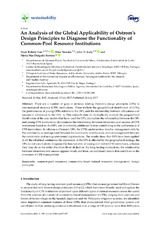An Analysis of the Global Applicability of Ostrom’s Design Principles to Diagnose the Functionality of Common-Pool Resource Institutions
Autor
Gari, Sirak Robele
Newton, Alice
Icely, John D.
Delgado Serrano, María del Mar
Editor
MDPIFecha
2017Materia
Common-pool resourcesCommunity-based natural resources management
Design principles
METS:
Mostrar el registro METSPREMIS:
Mostrar el registro PREMISMetadatos
Mostrar el registro completo del ítemResumen
There are a number of gaps in reviews relating Ostrom’s design principles (DPs) to
common-pool resource (CPR) institutions. These include the geographical distribution of CPRs,
the performance of young CPRs relative to the DPs, and the relationship between robustness and
success in adherence to the DPs. to This research aims to: (i) explicitly analyze the geographical
distribution of the case studies that have used the DPs, (ii) explore the relationship between the DPs
and young CPR institutions, (iii) examine the relationship between robustness and success of CPR
institutions based on the DPs, and (iv) identify additional factors contributing to the performance of
CPR institutions. In relation to Ostrom’s DPs, the CPRs under review involve management only by
the community, co-management between the community and the state, and co-management between
the community and non-governmental organizations. The results show that: DPs have been applied
in all the inhabited continents; the expression of the DPs is affected by the geographical settings; the
DPs do not conclusively diagnose the functionality of young and viable CPR institutions, whereas
they may do so for either the short-lived (failed) or the long-lasting institutions; the relationship
between robustness and success appears weak; and there are additional factors that contribute to the
outcomes of CPR management

